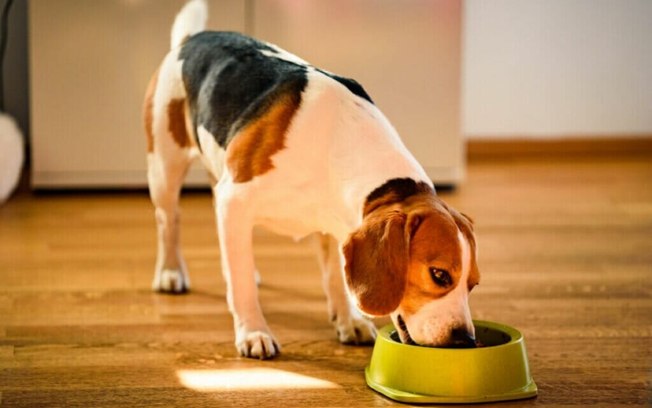Natural food for dogs, despite not being new, is a source of confusion for many people. Even with the benefits, there are doubts about how the food should be prepared, which ones can be used and the appropriate measure. But one thing is certain: the taste and texture tend to please pets.
This food is prepared individually and adapted to the nutritional needs, clinical and physical state of each animal. It can be offered to all types of dogs: young, adult, elderly, neutered or not.
“This diet is more palatable, has fewer preservatives, firmer, odor-free stools, gastrointestinal protection in general, boosts the immune system, prevents diseases and promotes healthy hair and skin,” explains veterinarian Aluizio Nunes dos Santos.
Differences between pet food and natural food
Natural food is usually more attractive to animals because its texture and flavor are more pleasing to the palate. In addition, some dogs may be allergic to animal protein, in which case they can adhere to a diet rich in vegetable protein.
But, according to the vet, the great advantage of pet food is its practicality, as it requires no preparation. “The disadvantage is that it is prepared using a ‘fixed’ formula, following an organization chart. Therapeutic feed treats only one type of disease, because it has a ready-made formula,” he explains.
Also according to Aluizio Santos, because it treats only one type of disease, the use of therapeutic feed can aggravate other symptoms. “Whereas the advantage of natural food is that it is adjusted with variable levels of nutrients and adapted for dogs that have more than one disease, for example, allergies and urinary calculi,” he says.
Advantages of natural food
The vet explains that the composition of the food is balanced and mathematically elaborated. “Most are made up of a higher percentage of carbohydrates, called ether extract. Some feed contains transgenic corn and soy, offal and other processed parts that are not suitable for human consumption, as well as preservatives, which can be carcinogenic. Because it is a dry food, it only contains 10% water.”
Natural food, on the other hand, has a lower percentage of ether extract and the amount of water present is 60 to 80% in total. “The big difference between a natural diet and pet food is that it seeks to adapt the food to improve the digestion of pets. The physiology of chewing proves this to us, since the teeth of pets are adapted to tearing the food and not crushing it, as is the case with food,” says Aluizio Santos.
Better hydration and protection against obesity
The natural diet can provide a water content 7 times higher than conventional diets, which helps preserve the animal’s renal system. As a result, there is no need for a large intake of liquid.
“The glycemic load is lower, since the natural diet does not contain the high levels of carbohydrates found in conventional diets, which use grains as their raw material. This is beneficial for controlling obesity“, analyzes the professor.
See a vet before changing the diet
As a general rule, any breed can adhere to the natural diet, but the ideal is to see a vet to check if your dog has any restrictions or intolerances. “An example of this would be animals that have carbohydrate intolerance or pre-existing illnesses in which there is a restriction on carbohydrates, as in diabetes, and proteins, in the case of kidney failure,” explains Aluizio Santos.
Dish assembly
The most suitable foods are fruit and vegetables. The professional explains how a balanced meal should be composed: “The proportion should be carefully calculated, even allowing for natural supplementation. The diet is made up of 30% boneless meat (protein), 30% vegetables and 35% carbohydrates (macronutrients).”
According to him, the diet can also be supplemented with good quality vegetable oil, such as olive oil, coconut oil or linseed oil. “It can also be supplemented with whole grain salt and fish oil. The important thing is to keep in mind the pet’s nutritional needs, which will be met through a menu prepared by a professional specializing in animal nutrition,” he says.
Careful with the use of spices in food
According to Aluizio Santos, dogs don’t need several flavours in every meal. “The taste buds of our pets are much more refined. And spices, in general, are not tolerated. Some of them, like onion, can cause blood idiosyncrasies, such as oxidation of red blood cells. Others can directly affect liver metabolism and the gastrointestinal tract, causing diarrhea,” he warns.
Choose only one type of food
According to Aluizio Santos, it is not contraindicated to mix pet food with natural food, but there is no purpose in combining the two. “The natural diet is a perfect substitute for conventional feed, there is no synergism and over-supplementation and excess nutrients can occur, overloading the renal, hepatic and gastrointestinal systems,” he points out.
The right amount of food
When deciding on the right amount of food, you need to take into account the size of the dog, as well as its age and specific issues, such as metabolism and maturity related to age and breed. “It is generally calculated based on body weight. An adult dog should receive between 3 and 10% of its weight daily; a small dog should receive between 8 and 10% of its weight,” explains the vet.
Also according to him, meal intervals “differ because there are issues to consider, such as the speed of metabolism. It’s important that the calculation is made based on your pet’s ideal weight. Meals should be eaten twice a day,” he adds.
Frequency of food preparation
According to the expert, meals do not need to be prepared every day. “It’s perfectly possible to draw up a menu, prepare a large quantity of food and freeze it in small portions, so that it can be offered piecemeal for up to 30 days,” he adds.
Fruits that can be offered to dogs
Fruits are healthy options for both humans and dogs. However, not all of them are suitable for dogs. “Fruits such as bananas, kiwi and strawberries can be offered, apples and oranges, although citrus fruits, too, as long as the seeds are removed, as can watermelon, pears, peaches and persimmons. However, citrus fruits and so-called laxatives, such as avocado and papaya, should be avoided. Grape seeds are toxic to our pets’ bodies,” explains Aluizio Santos.
Prohibited foods for dogs
Some foods are not tolerated by dogs for metabolic and physiological reasons. “Like onions, which oxidize red blood cells and cause them to break down. Pasta in general can cause abdominal distension and pain due to the presence of yeast, leading the pet to develop colic and gas production,” says the vet.
The substance methylxanthine, present in chocolate, “can lead to cases of serious poisoning and, if not identified and treated in time, can lead to death. Sweets are contraindicated, as they can cause obesity and dental problems, as well as diabetes,” he adds.
The use of dairy products is also prohibited, as they can lead to serious gastrointestinal problems. “Products such as minas and cottage cheese can be offered, as they don’t contain lactose, but rather casein, which is a protein found in whey,” explains Aluizio Santos. In fact, all animal protein should be offered after cooking, to avoid contamination by microorganisms.


